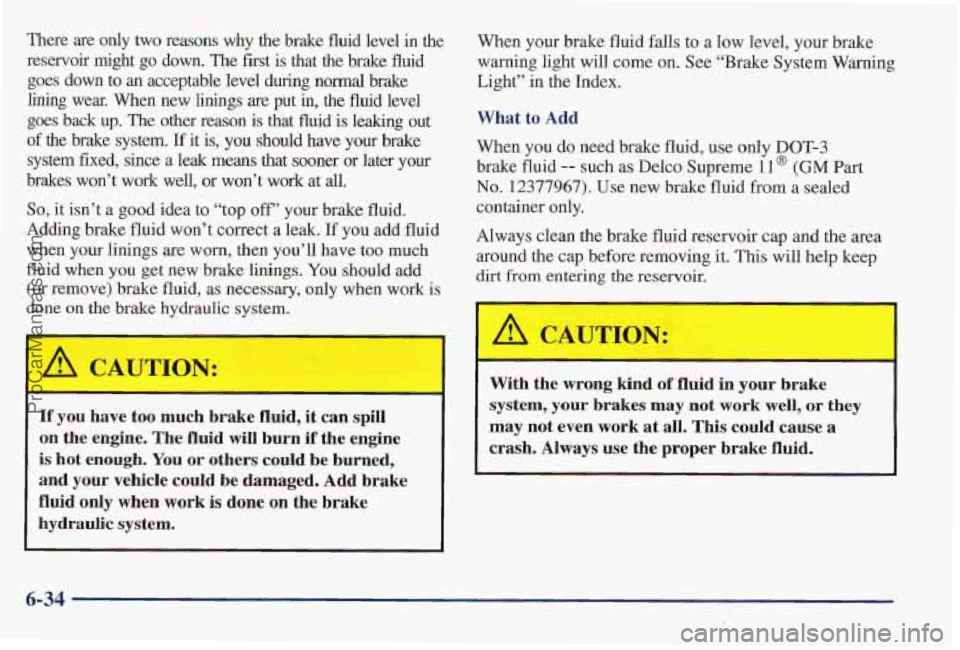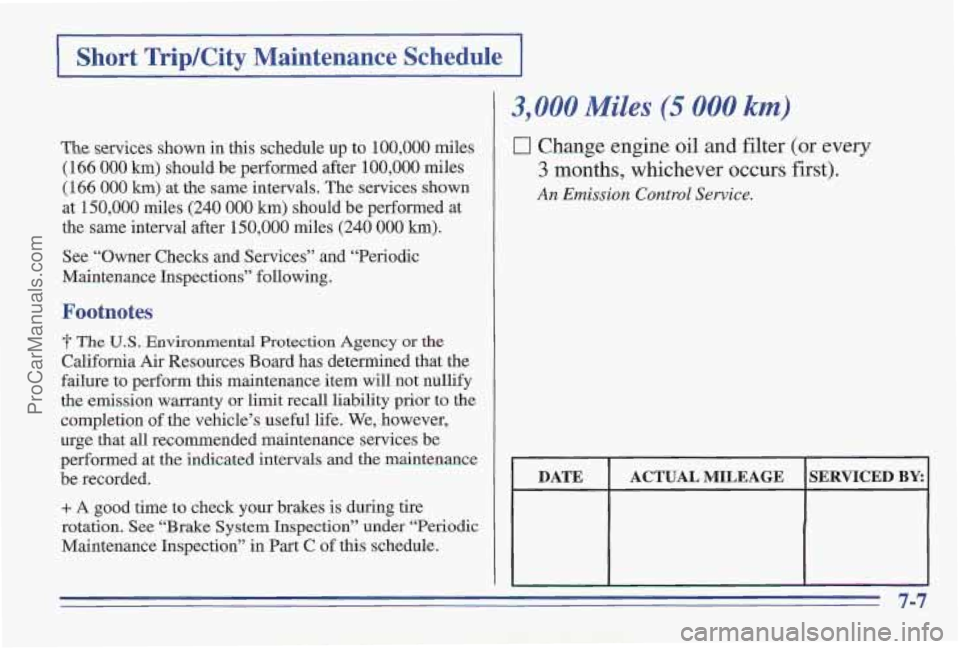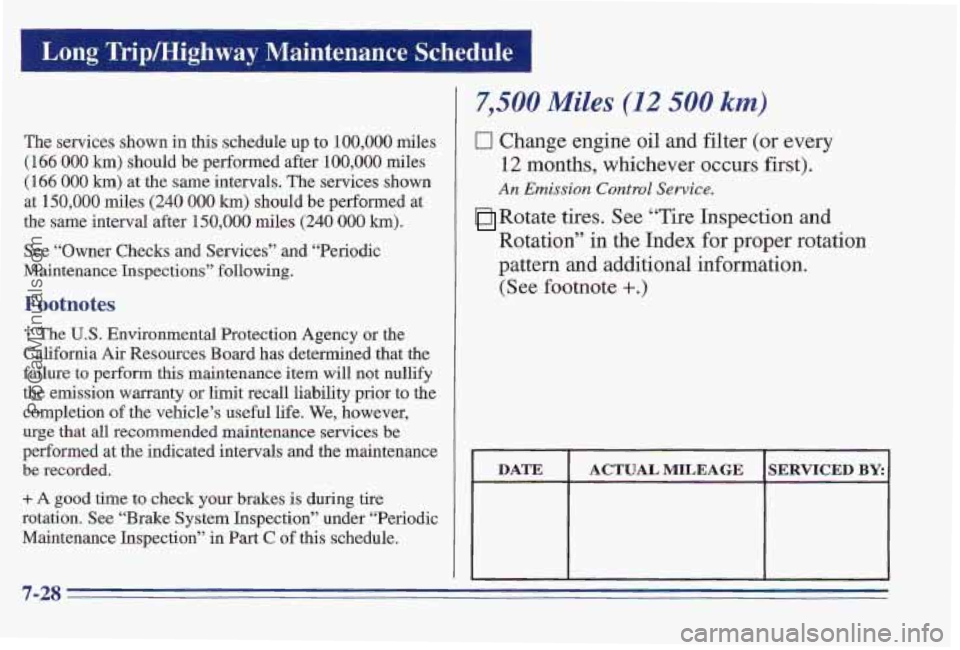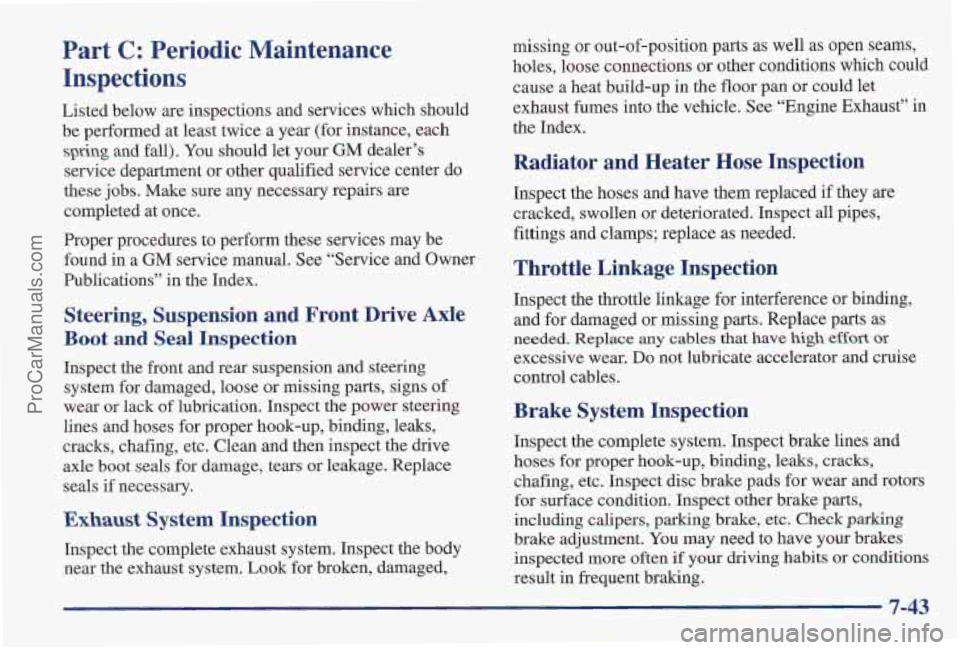1997 PONTIAC PONTIAC brakes
[x] Cancel search: brakesPage 304 of 419

There are only two reasons wny the brake fluid level in the
reservoir might go down. The first is that the brake fluid
goes down to an acceptable level during normal brake
lining wear. When new linings are put in, the fluid level
goes back
up. The other reason is that fluid is leaking out
of the brake system. If it is, you should have your brake
system fixed, since a leak means that sooner or later your
brakes won’t work well, or won’t work at all.
So, it isn’t a good idea to “top off’ y’our brake fluid.
Adding brake fluid won’t correct a leak. If you add fluid
when your linings are worn, then you’ll have
too much
fluid when
you get new brake linings. You should add
(or remove) brake fluid, as necessary, only when work
is
done on the brake hydraulic system.
If you have too much brake fluid, it can spill
on the engine. The fluid will burn
if the engine
is hot enough. You or others could be burned,
and your vehicle could be damaged. Add brake
fluid only when work
is done on the brake
hydraulic system. When your brake
fluid falls
to a low level, your brake
warning light will come on. See “Brake System Warning
Light” in the Index.
What
to Add
When you do need brake fluid,
use only DOT-3
brake fluid -- such as Delco Supreme 11 @ (GM Part
No. 12377967). Use new brake fluid from a sealed
container only.
Always clean the brake fluid reservoir cap and
the area
around the cap before removing
it, This will help keep
dirt from entering the reservoir.
With the wrong kind
of fluid in your brake
system, your
brakes may not work well, or they
may not even work at all. This could cause
a
crash. Always use the proper brake fluid.
6-34
ProCarManuals.com
Page 305 of 419

NOTICE:
Using the wrong fluid can badly damage
brake system parts.
For example, just a few
drops of mineral-based oil, such as engine
oil, in your brake system can damage brake
system parts
so badly that they’ll have to be
replaced. Don’t let someone put in the
wrong kind of fluid.
If you.spil1 brake fluid on your vehicle’s
painted surfaces, the paint finish can be
damaged. Be careful not to spill brake fluid
on your vehicle.
If you do, wash it off
immediately. See “Appearance Care” in
the Index.
Brake Wear
Your Pontiac has four-wheel disc brakes.
Disc brake pads have built-in wear indicators that make a
high-pitched warning sound when the brake pads are
worn and new pads are needed. The sound may come and
go
or be heard all the time your vehicle is moving (except
when
you are pushing on the brake pedal firmly).
The brake wear warning sound means that soon
your brakes won’t work well. That could lead
to
an accident. When you hear the brake wear
warning sound, have your vehicle serviced.
NOTICE:
Continuing to drive with worn-out brake pads
could result in costly brake repair.
6-35
ProCarManuals.com
Page 306 of 419

Some driving conditions or climates may cause a brake
squeal when the brakes are first applied or lightly
applied.
This does not mean something is wrong with
your brakes.
Properly torqued wheel
nuts are necessary to help
prevent brake pulsation, When tires are rotated, inspect
brake pads for wear, and evenly torque wheel nuts in
the proper sequence
to GM specifications.
Brake linings should always be replaced as complete
axle sets.
See “Brake System Inspection” in section
7 of this
manual under
Part C “Perodic Maintenance Inspections,”
Brake Pedal Travel
See your dealer if the brake pedal does not return to
normal height,
or if there is a rapid increase in pedal
travel. This could be a sign of brake trouble.
Brake Adjustment
Every time you apply the brakes, with or without the
vehicle moving, your
brakes adjust for wear.
Replacing Brake System Parts
The braking system on a modern vehicle is complex. Its
many parts have to be of top quality and work well
together if the vehicle is to have really good braking.
Vehicles we design and test have top-quality
GM brake
parts in them,
as your Pontiac does when it is new.
When you replace parts of your braking system
-- for
example, when your brake linings wlear down and you
have to have new ones put in
-- be sure you get new
approved
GM replacement parts. If you don’t, your
brakes may no longer work properly. For example,
if
someone puts in brake linings that are wrong for your
vehicle, the balance between your front and rear brakes
can change -- for the worse. The braking performance
you’ve come to expect can change in many other ways
if
someone puts in the wrong replacement brake parts.
Battery
Every new Pontiac has a Delco Freedom@ battery. You
never have
to add water to ‘one of these. When it’s time
for a new battery, we recommend a Delco Freedom
battery. Get one that has
the replacement number shown
on the original battery’s label.
ProCarManuals.com
Page 339 of 419

Fuse
ECM
CRUISE
I/P-IGN SIR
TURN
ABS
BTSI
HVAC CTRL
DIC/HVAC
AB’S IGN
DRL
Description
ECM
Cruise Control ChimeMall Module, Cluster, Trip
Computer, Head-Up Display,
Brake-Transaxle Shift Interlock
Supplemental Inflatable Restraint
(Air
Bag)
Turn Signal
Anti-Lock Brakes
PRNDL, Brake-Transaxle Shift Interlock
Blower Control, HVAC
Rear Defog, HVAC, Driver
Information Center, Daytime
Running Lamps, Heated Seats
Anti-Lock Brakes Ignition
Daytime Running Lamps
Underhood Electrical Center
-- Passenger’s Side
Some fuses are in a fuse block on the passenger’s side of
the engine compartment. Pull off the cover labeled
FUSES to expose the fuses.
6-69
ProCarManuals.com
Page 351 of 419

1 Short Trip/City Maintenance Schedule I
The services shown in this schedule up to 100,000 miles
(166 000 km) should be performed after 100,000 miles
(166 000 km) at the same intervals. The services shown
at
150,000 miles (240 000 km) should be performed at
the same interval after 150,000 miles
(240 000 km).
See “Owner Checks and Services” and “Periodic
Maintenance Inspections” following.
Footnotes
? The U.S. Environmental Protection Agency or the
California Air Resources Board has determined that the
failure to perform this maintenance item will not nullify
the emission warranty or limit recall liability prior
to the
completion of the vehicle’s useful life. We, however,
urge that all recommended maintenance services be
performed at the indicated intervals and the maintenance
be recorded.
+ A good time to check your brakes is during tire
rotation. See
“Brake System Inspection” under “Periodic
Maintenance Inspection” in Part
C of this schedule.
3,000 Miles (5 000 km)
0 Change engine oil and filter (or every
3 months, whichever occurs first).
An Emission Control Service.
DATE ACTUAL MILEAGE SERVICED BY:
7-7
ProCarManuals.com
Page 372 of 419

Long Trip/Highway Maintenance Schedule
The services shown in this schedule up to 100,000 miles
(166
000 km) should be performed after 100,000 miles
(166 000 km) at the same intervals. The services shown
at
150,000 miles (240 000 km) should be performed at
the same interval after 150,000 miles
(240 000 km).
See “Owner Checks and Services” and “Periodic
Maintenance Inspections” following.
Footnotes
The U.S. Environmental Protection Agency or the
California Air Resources Board has determined that the
failure to perform
this maintenance item will not nullify
the emission warranty
or limit recall liability prior to the
completion
of the vehicle’s useful life. We, however,
urge
that all recommended maintenance services be
performed at the indicated intervals and the maintenance
be recorded.
+ A good time to check your brakes is during tire
rotation.
See “Brake System Inspection” under “Periodic
Maintenance Inspection” in Part
C of this schedule.
7,500 Miles (12 500 km)
0 Change engine oil and filter (or
every
12 months, whichever occurs first).
Rotate tires. See “Tire Inspection and
Rotation” in the Index
for proper rotation
pattern
and additional information.
(See footnote +.>
An Emission Control Sewice.
7-28
ProCarManuals.com
Page 386 of 419

Ignition Transaxle Lock Check
While parked, and with the parking brake set, try to turn
the ignition key to LOCK in each shift lever position.
The key should turn to LOCK only when the shift
The key should come out only in LOCK.
lever is in PARK (P).
Parking Brake and Automatic Transaxle PARK (P)
MecT nism I-- leck
Park on a fairly steep hill, with the vehicle facing
downhill. Keeping your foot
on the regular brake, set the
parking brake,
To check the p,arking brake's holding ability: With
the engine running and transaxle in
NEUTRAL (N),
slowly remove foot pressure fiom the regular brake
pedal.
D'o this until the vehicle is held by the parking
brake only.
To check the PARK (P) mechanism's holding ability:
With
the engine running, shift to PARK (a). Then
release all brakes.
I
Underbody Flushing Service
When you are
d ng this check, your vehicle At least every spring, use plain water
to flush any
corrosive materials
from the underbody. Take care to could begin to move. You or others could be clean thoroughly any areas where mud and other debris
injured and property could be damaged. Make can collect.
sure there is room in front of your vehicle in case
it begins to roll. Be ready to apply the regular
brake at
once should the vehicle begin to move.
7-42
ProCarManuals.com
Page 387 of 419

Part C: Periodic Maintenance
Inspections
Listed below are inspections and services which should
be performed at least twice a year (for instance, each
spring and fall). You should let your GM dealer’s
service department or other qualified service center do
these
jobs. Make sure any necessary repairs are
completed at once.
Proper procedures to perform these services may be
found
in a GM service manual. See “Service and Owner
Publications” in the Index.
Steering, Suspension and Front Drive Axle
Boot and Seal Inspection
Inspect the front and rear suspension and steering
system for damaged, loose or missing parts, signs of
wear or lack of lubrication. Inspect the power steering
lines and hoses for proper hook-up, binding, leaks,
cracks, chafing, etc. Clean and then inspect the drive
axle boot seals for damage, tears or leakage. Replace
seals if necessary.
Exhaust System Inspection
Inspect the complete exhaust system. Inspect the body
near the exhaust system. Look for broken, damaged, missing
or out-of-position parts as well
as open seams,
holes, loose connections or other conditions which could
cause a heat build-up in
the floor pan or could let
exhaust fumes into the vehicle. See “Engine Exhaust” in
the Index.
Radiator and Heater Hose Inspection
Inspect the hoses and have them replaced if they are
cracked, swollen or deteriorated. Inspect all pipes,
fittings and clamps; replace as needed.
Throttle Linkage Inspection
Inspect the throttle linkage for interference or binding,
and for damaged or missing parts. Replace parts as
needed. Replace any cables that have high eEort or
excessive wear. Do not lubricate accelerator and cruise
control cables.
Brake System Inspection
Inspect the complete system. Inspect brake lines and
hoses
for proper hook-up, binding, leaks, cracks,
chafing, etc. Inspect disc brake pads for wear and rotors
for surface condition. Inspect other brake parts,
including calipers, parking brake,
etc. Check parking
brake adjustment. You may need to have your brakes
inspected more often
if your driving habits or conditions
result in frequent braking.
ProCarManuals.com